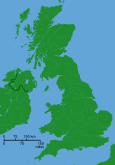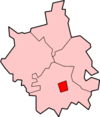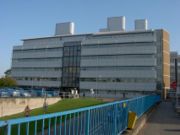Cambridge
2007 Schools Wikipedia Selection. Related subjects: Geography of Great Britain
| Cambridge | ||
 Kings College Chapel, seen from The Backs. |
||
| City of Cambridge | ||
|---|---|---|
|
|
||
| Geography | ||
| Status: | City (1951) | |
| Region: | East of England | |
| Admin. County | Cambridgeshire | |
| Area - Total |
Ranked 316th 40.70 km² |
|
| Admin. HQ | Cambridge | |
| ONS code | 12UB | |
| Coordinates | ||
| Demographics | ||
| Population: - Total (2005 est.) - Density |
Ranked 157th 124,000 3,047 / km² |
|
| Ethnicity |
89.4% White 4.4% Mixed Race/Other 3.8% S.Asian 1.3% Afro-Carib. 2.1% Chinese |
|
| Politics | ||
 Cambridge City Council http://www.cambridge.gov.uk/ |
||
| Leadership: | Leader & Cabinet | |
| Executive | Liberal Democrats | |
| MP | David Howarth | |
| MP(2) | Andrew Lansley | |
The city of Cambridge is an old English university town and the administrative centre of the county of Cambridgeshire. It lies approximately 50 miles (80 km) north-northeast of London and is surrounded by a number of smaller towns and villages. It is also at the heart of the high-technology centre known as Silicon Fen and is one of the major constituent parts of the Oxford-Cambridge Arc.
Cambridge is best known for the University of Cambridge, which includes the renowned Cavendish Laboratory, King's College Chapel, and the Cambridge University Library. The Cambridge skyline is dominated by the last two, along with the chimney of Addenbrooke's Hospital in the far south of the city and St John's College Chapel tower in the north. The city's name is pronounced /'keɪm.bɹɪdʒ/, as opposed to another Cambridge in Gloucestershire, England, which is pronounced /'kæm.bɹɪdʒ/.
According to the 2001 census, the population was 108,863 (including 22,153 students).
History
Settlements have existed around the area since before the Roman Empire. The earliest clear evidence of occupation, a collection of hunting weapons, is from the Late Bronze Age, starting around 1000 BC. There is further archaeological evidence through the Iron Age, a Belgic tribe having settled on Castle Hill in the 1st century BC.
The first major development of the area began with the Roman invasion of Britain in about AD 40. Castle Hill made Cambridge a useful place for a military outpost from which to defend the River Cam. It was also the crossing point for the Via Devana which linked Colchester in Essex with the garrisons at Lincoln and the north. This Roman settlement may have been called Durolipons.
The settlement remained a regional centre during the 350 years after the Roman occupation, until about AD 400. Roman roads and walled enclosures can still be seen in the area.
After the Romans had left, Saxons took over the land on and around Castle Hill. Their grave goods have been found in the area. During Anglo-Saxon times Cambridge benefited from good trade links across the otherwise hard-to-travel fenlands. By the 7th century, however, visitors from nearby Ely reported that Cambridge had declined severely. Cambridge is mentioned in the Anglo-Saxon Chronicle as Grantebrycge. This is the earliest known reference to a bridge at Cambridge.
The arrival of the Vikings in Cambridge was recorded in the Anglo-Saxon Chronicle in 875. Viking rule, the Danelaw, had been imposed by 878. The Vikings' vigorous trading habits caused Cambridge to grow rapidly. During this period the centre of the town shifted from Castle Hill on the left bank of the river to the area now known as the Quayside on the right bank. After the end of the Viking period the Saxons enjoyed a brief return to power, building St Benet's church in 1025. It still stands in Bene't Street.
In 1068, two years after his conquest of England, William of Normandy built a castle on Castle Hill. Like the rest of the new kingdom, Cambridge fell under the control of the King and his deputies. The distinctive Round Church dates from this period. By Norman times the name of the town had mutated to Grentabrige or Cantebrigge (Grantbridge), while the river that flowed through it was called the Granta.
Over time the name of the town changed to Cambridge, while the river Cam was still known as the Granta - indeed the river is still often known as the Granta to this day. The Welsh language name of the town remains Caergrawnt (roughly analogous to Grantchester, which is also the name of a village near Cambridge). It was only later that the river became known as the Cam, by analogy with the name Cambridge. The University, formed 1209, uses a Latin adjective cantabrigiensis (often contracted to "Cantab") to mean "of Cambridge", but this is obviously a back-formation from the English name.
Beginnings of the University
In 1209, students escaping from hostile townspeople in Oxford fled to Cambridge and formed a University there. The oldest college that still exists, Peterhouse, was founded in 1284. One of the most impressive buildings in Cambridge, King's College Chapel, was begun in 1446 by King Henry VI. The project was completed in 1515 during the reign of King Henry VIII.
Cambridge University Press originated with a printing licence issued in 1534. Hobson's Conduit, the first project to bring clean drinking water to the town centre, was built in 1610 (by the Hobson of Hobson's choice). Parts of it survive today. Addenbrooke's Hospital was founded in 1766. The railway and station were built in 1845. According to legend, the University dictated their location: well away from the centre of town, so that the possibility of quick access to London would not distract students from their work. However, there is no basis for this in fact.
Cambridge University played a unique role in the invention of modern football as the game's first set of rules were drawn up by members of the university in 1848. The Cambridge Rules were first played in Parker's Piece and had a "defining influence on the 1863 Football Association rules."
Despite having a University, Cambridge was not granted its city charter until 1951. Cambridge does not have a cathedral, which was traditionally a pre-requisite for city status.
Cambridge today
Drawing on its links with the University, the Cambridge area today is sometimes referred to as Silicon Fen, due to the growth of high tech businesses and technology incubators that have sprung up in the series of science parks and other developments in and around the city. Such companies include Acorn Computers and Sinclair. The University was joined by the larger part of Anglia Ruskin University, and the educational reputation has led to other bodies (such as the Open University in East Anglia) basing themselves in the city.
The University has a large number of museums that are open to the public.
Housing estates
Throughout the 1960s and 70s the size of the city was greatly increased by several large council estates planned to hold London's overspill. The biggest impact has been on the area north of the river, which is now home to the estates of Arbury, East Chesterton and King's Hedges, whilst there are many smaller estates to the south of the city.
Government
Local government
Cambridge is a non-metropolitan district, with a city council. The city council's headquarters are in the Guildhall, an imposing building in the market square.
Cambridge is also served by Cambridgeshire county council.
For electoral purposes the city is divided into the following wards: Abbey, Arbury, Castle, Cherry Hinton, Coleridge, East Chesterton, Kings Hedges, Market, Newnham, Petersfield, Queen Edith's, Romsey, Trumpington, West Chesterton.
The political composition of the city wards of the county council after the May 2005 elections was ( ):
- 10 Liberal Democrat seats
- 4 Labour seats
- 0 Conservative seats
The political composition of the city council after the May 2006 elections was:
- 29 Liberal Democrat councillors
- 13 Labour councillors
The Liberal Democrats have controlled the city council since 2000.
Westminster
The parliamentary constituency of Cambridge covers most of the city. David Howarth ( Liberal Democrat) was elected MP at the 2005 general election, winning the seat from the sitting MP, Labour's Anne Campbell. Some areas, however — corresponding largely to the Queen Edith's and Trumpington wards — lie in the South Cambridgeshire constituency, whose MP is Andrew Lansley ( Conservative), first elected in 1997.
The University used to have a seat in the House of Commons, Sir Isaac Newton being one of the most notable holders. The Cambridge University constituency was abolished under 1948 legislation, and ceased at the dissolution of Parliament for the 1950 general election, along with the other university constituencies.
Affiliations
Cambridge is twinned with:
Transport
Roads
Because of its rapid growth since the 20th century, Cambridge has a congested road network. Several major roads intersect at Cambridge. The M11 motorway from east London terminates here. The A14 (formerly A604 and A45) east-west trunk route skirts the northern edge of the city. This is a major freight route connecting the port of Felixstowe on the east coast with the Midlands, North Wales, the west coast and Ireland. The A14 is considered by many local people to be dangerous, and unnecessarily congested. This is particularly true of the section between Huntingdon and Cambridge where the east-west traffic is merged with the A1 to M11 north-south traffic on just a 2-lane dual carriageway. The A10, a former Roman road from north London, passes round the city on its way to Ely and King's Lynn. Other roads connect the city with Bedford, St Neots, Newmarket and Colchester.
The city has a ring road about 2 km in diameter, inside which there are traffic restrictions intended to improve conditions for pedestrians, cyclists and bus users and to reduce congestion. It has a well developed park and ride bus service encouraging motorists to park near the city's edge.
Rail
Cambridge railway station was built in 1845 with a platform designed to take two full-length trains. Cambridge has direct rail links to King's Cross (via Hitchin and the East Coast Main Line) and Liverpool Street (via the West Anglia Main Line) stations in London. It is also linked to King's Lynn and Ely (via the Fen Line), Norwich (via the Breckland Line), Liverpool, Birmingham, Ipswich and as well as London Stansted Airport. The important UK rail hub of Peterborough is also within reach of Cambridge. The railway service connecting Cambridge and Oxford, known as the Varsity Line, was discontinued in 1968.
Air
Cambridge City Airport is owned by Marshall Aerospace, who are capable of adapting and fitting out military transports, airliners and corporate jets, and most notably has been involved in fitting out the world's largest airliner, the Airbus A380. The runway can accommodate an unladen Boeing 747 or MD-11, but there is no regular scheduled service and it is mostly used by business and leisure flights. In Summer 2004 a charter service to Jersey was operated by Aurigny Air Services using Saab 340 turboprop aircraft. A dealer in fibreglass-moulded light monoplanes is also based here. Removal of Marshalls to a site away from the city, with development of the airport site for housing, is a possibility over the next 5-10 years.
Cycling
As a university town lying on fairly flat ground and with traffic congestion, Cambridge has a large number of cyclists. Many residents also prefer cycling to driving in the narrow, busy streets, giving the city the highest level of cycle use in the UK. According to the 2001 census, 25% of residents travelled to work by cycle. A few roads within the city are adapted for cycling, including separate traffic lights for cycle lanes and cycle contraflows on streets which are otherwise one-way; the city also benefits from parks which have shared use paths. There are, however, no separate cycle paths within the city centre. Despite the high levels of cycling, expenditure on cycling infrastructure is around the national average of 0.3% of the transport budget. There are a few cycle routes in the surrounding countryside and the city is now linked to the National Cycle Network. The main organisation campaigning to improve conditions for cyclists in Cambridge is Cambridge Cycling Campaign.
Sport
Cambridge's most successful sports team over recent years is its rugby union club. After three successive promotions they are playing in National Division Two for the 2006/07 season. The club's home ground is at West Renault Park on Granchester Road in the south west corner of the city.
The city is home to Cambridge United F.C., who played in the Football League at the Abbey Stadium from 1970 to 2005, when they were relegated to Conference National. When relegation became inevitable the club was placed in administration with substantial debts, but it emerged from administration in time for the 2005-2006 season. Non-league Cambridge City F.C. play at Milton Road in Chesterton.
Cambridge is also known for its university sporting events against Oxford, especially the rugby union Varsity Match and the Boat Race. These are followed by people across the globe, many of whom have no connection to the institutions themselves.
The City Council hosts details of Local Sports Clubs.
Cambridge has a King George's Field, named as a memorial to King George V.
Health
Cambridge is well served by medical care, with several smaller medical centres dotted around the city, along with Addenbrooke's Hospital a learning and teaching hospital and one of the largest in the United Kingdom, also functioning as a centre for medical research.
Multicultural Cambridge
For its size, Cambridge has a relatively diverse ethnic population. This is mainly due to people from other countries coming to study at the University. The area around Mill Road has a large Turkish population, and is home to many Asian food stores and the Abu Bakr Mosque.
Religion
Cambridge has an active Christian population which makes use of the many churches that dominate the town's landscape. Great St Mary's church has the status of being the "University Church", and official university sermons take the part of services there. Many of the University colleges contain chapels that hold services according to the rites and ceremonies of the Church of England, while at least one is Roman Catholic. There is also a mosque used by Muslim residents and students, and a synagogue belonging to the university Jewish Society.
The town also has a number of ecclesiastical colleges for training clergy for ordination into a number of denominations, with affiliations to both the University of Cambridge and Anglia Ruskin Universiy.
Fiction
In the 1950s, the English children's writer Philippa Pearce created a fictionalised version of Cambridge known as "Castleford" (not connected to the real town of the same name in West Yorkshire). It appears in several of her books, most notably Tom's Midnight Garden and Minnow on the Say. The main distinguishing point between "Castleford" and the real Cambridge is that this "Castleford" does not have a university, apparently because the author wanted the readers to think of the town in itself, and she felt that Cambridge was too closely associated with its university in the public imagination for this to be possible.
Tom Sharpe is also a Cambridge-based author who has written fictional accounts of teaching at Cambridge Technical College (now Anglia Ruskin University) and of Cambridge college life.
Susanna Gregory wrote a series of novels set in 14th-century Cambridge and featuring a teacher of medicine and sleuth named Matthew Bartholomew.
Douglas Adams was at one time a resident of Cambridge, and parts of his novel Dirk Gently's Holistic Detective Agency are set in the city. This novel was partially reworked from his unbroadcast Doctor Who serial Shada, which also included scenes in Cambridge.
Sylvia Plath wrote a number of short stories with a Cambridge setting which are published in the collection Johnny Panic and the Bible of Dreams.
Dame Rose Macaulay had strong connections to the city, and set part of her novel They Were Defeated in the city during the reign of Charles I.
A number of novels in C.P.Snow's Strangers and Brothers series (The Masters, The Affair) are set in a Cambridge college (a thinly-veiled Christ's).
Kate Atkinson used the town as the setting for her book Case Histories.
Michelle Spring wrote a series of novels about a Cambridge-based private detective, Laura Principal, beginning with Every Breath You Take (1994).
Cambridge fiction is extracted and discussed in Graham Chainey, "A Literary History of Cambridge" (Cambridge, 1985, 1995; ISBN 090711525X) and Martin Garrett, "Cambridge: a Cultural and Literary History" (Oxford, 2004; ISBN 1902669797).
Festivals and events
- Cambridge Midsummer Fair is one of the oldest fairs in the UK and at one point was possibly the largest medieval fair in Europe. Today it exists primarily as an annual funfair with the vestige of a market attached.
- Cambridge Folk Festival is one of the largest festivals of folk music in the UK
- Strawberry Fair, is a free, public fair. It is held every first Saturday in June on Midsummer Common.
- Cambridge Beer Festival, which began in 1973. It takes place on Jesus Green for one week in May every year and is staffed solely by volunteers.
- The Cambridge Film Festival is held annually in July and is considered to be one of the nation's best.
Notable residents
- Stephen Hawking, physicist.
- Ronald Searle, cartoonist.
- Rory McGrath, comedian.
- Jeffrey Archer, author and former politician.
- David Gilmour, Roger Waters, and the late Syd Barrett, founding (excepting Gilmour) members of the rock band Pink Floyd.
Trivia
- In 2004, Cambridge was granted Fairtrade City status.
- In 2004, the famous board game Monopoly enjoyed the publication of a Cambridge edition .





![The market in the centre of Cambridge, with Great St Mary's Church in the background · more [1]](../../images/25/2569.jpg)


